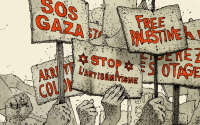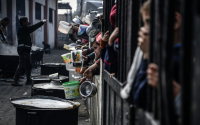The lawyers, journalists, students and the poor demonstrating in Kathmandu also know that if they are massacred, the armed guerrillas who control 80% of the countryside will take the country. This is not one of those carefully orchestrated "orange" affairs with its mass-produced placards, rah-rah gals and giant PR firms to aid media coverage, so loved by the "international community". Nor does the turbulence have anything to do with religion. What is taking place in Nepal is different: it is the culmination of decades of social, cultural and economic oppression. This is an old story. Nepal's upper-caste Hindu rulers have institutionalised ancient customs to preserve their own privileges. Only last year was the custom of locking up menstruating women in cowsheds declared illegal.
The Nepalese monarchy, established more than two centuries ago, has held the country in an iron grip, usually by entering into alliances with dominant powers - Britain, the US and, lately, India - and keeping them supplied with cheap mercenaries. It is a two-way trade and ever since the declaration of the "war on terror", the corrupt and brutal royal apparatus has been supplied with weaponry by its friends: 20,000 M-16 rifles from Washington, 20,000 rifles from Delhi and 100 helicopters from London. Meanwhile, half the country's 28 million people have no access to electricity or running water, let alone healthcare and education, according to the UN.
In 2005, King Gyanendra suspended all civil liberties and outlawed politics. To deal with a problem that was essentially structural, but which in the global context of neoliberalism could not be solved through state intervention, he decided on mass repression: physical attacks on the poor, concerted attempts to stamp out dissident political organisations and blanket social repression. The chronicle of shootings, beatings, imprisonments, purges and provocations is staggering. The sheer ferocity of his assault took the tiny middle class by surprise and isolated the politicians.
Will the triumvirate - the US, the EU and the UN security council - try to keep the king in power? If it does, it will have to add Kathmandu to a growing list of disasters. Recent newspaper editorials indicate that the west fears the disease may spread to neighbouring India. A top-level summit between the Naxalites and civil servants after the defeat of the BJP government revealed a remarkably pragmatic Maoist leadership: all it wanted was for the government to implement the constitution and pledges contained in successive Congress manifestos.
What the uprising in Nepal reveals is that while democracy is being hollowed out in the west, it means more than regular elections to many people in the other continents. The Nepalese want a republic and an end to the systemic poverty that breeds violence and to achieve these moderate demands they are making a revolution.
· Tariq Ali is an editor of New Left Review [email protected]
#comments { font-size:70%; font-family:Geneva, Arial, Helvetica, sans-serif; } #comments div.commentheader p { font-size:1.2em; } #comments { clear:both; margin-top:25px; width:256px; } #comments h3 { color: #fff; padding:2px; margin-bottom: 10px; font-size:1.3em; background-color:#999; } .individualcomment { font-size:1.2em; clear:both; margin-top:10px; padding-top:10px; border-top:1px solid #999; } .dateline { font-weight: normal; color:#999; padding-top:2px; margin:0 0 15px 0; } .byline { font-weight:bold; padding:0; margin:0; }





